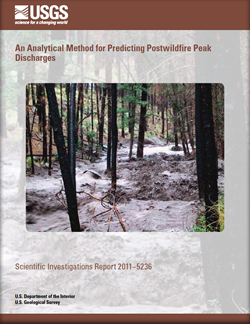 Abstract Abstract
An analytical method presented here that predicts postwildfire peak discharge was developed from analysis of paired rainfall and runoff measurements collected from selected burned basins. Data were collected from 19 mountainous basins burned by eight wildfires in different hydroclimatic regimes in the western United States (California, Colorado, Nevada, New Mexico, and South Dakota). Most of the data were collected for the year of the wildfire and for 3 to 4 years after the wildfire. These data provide some estimate of the changes with time of postwildfire peak discharges, which are known to be transient but have received little documentation. The only required inputs for the analytical method are the burned area and a quantitative measure of soil burn severity (change in the normalized burn ratio), which is derived from Landsat reflectance data and is available from either the U.S. Department of Agriculture Forest Service or the U.S. Geological Survey. The method predicts the postwildfire peak discharge per unit burned area for the year of a wildfire, the first year after a wildfire, and the second year after a wildfire. It can be used at three levels of information depending on the data available to the user; each subsequent level requires either more data or more processing of the data. Level 1 requires only the burned area. Level 2 requires the burned area and the basin average value of the change in the normalized burn ratio. Level 3 requires the burned area and the calculation of the hydraulic functional connectivity, which is a variable that incorporates the sequence of soil burn severity along hillslope flow paths within the burned basin. Measurements indicate that the unit peak discharge response increases abruptly when the 30-minute maximum rainfall intensity is greater than about 5 millimeters per hour (0.2 inches per hour). This threshold may relate to a change in runoff generation from saturated-excess to infiltration-excess overland flow. The threshold value was about 7.6 millimeters per hour for the year of the wildfire and the first year after the wildfire, and it was about 11.1 millimeters per hour for the second year after the wildfire.
|
First posted March 8, 2012
This report is presented in Portable Document Format (PDF); the latest version of Adobe Reader or similar software is required to view it. Download the latest version of Adobe Reader, free of charge. |